
Established at the Windsor Hotel in Montreal on November 26, 1917, the National Hockey League (NHL) emerged following the suspension of its predecessor organization, the National Hockey Association (NHA), founded in 1909 at Renfrew, Ontario. Initially featuring four Canadian teams, the league expanded to include American teams in 1924 with the addition of the Boston Bruins. The NHL experienced significant growth, particularly with the expansion to 18 teams in 1967, followed by further expansions in subsequent decades, leading to a total of 32 active teams by 2024.
The NHL regular season typically spans from October to April, comprising 82 games per team. Following the regular season, 16 teams advance to the Stanley Cup playoffs, culminating in a four-round tournament to determine the league champion. Moreover, the NHL ranks as the fifth-highest-grossing professional sports league globally by revenue, following esteemed counterparts such as the NFL, MLB, NBA, and EPL.
NHL Rules
The National Hockey League rules govern professional ice hockey played in the NHL. This includes infractions like offside and icing which result in stoppages and face-offs, while more serious violations lead to penalties.
These rules, which dictate playing equipment specifications, have evolved from the sport's inception in 1875. Although primarily for NHL games, they serve as the foundation for most North American ice hockey leagues. They differ slightly from international rules, such as those used in IIHF competitions like the Olympics. Notable distinctions include handling of fighting, icing, goaltender areas, helmet regulations, officiating protocols, timeouts, and play reviews.
Here's a concise overview of some common rules and practices:
1. Closing hand on puck: Players, excluding goaltenders, who catch the puck must immediately drop it to the ice. Failure to do so results in a two-minute minor penalty.
2. Faceoffs: Players take set positions around face-off circles, with only two players allowed inside the circle during a faceoff. The location of the faceoff is determined by the cause of the last stoppage in play.
3. Delay of Game: Actions such as deliberately shooting or batting the puck outside the playing area, displacing the goal, or failing to provide the proper number of players on the ice result in a two-minute minor penalty.
4. High-sticking: When an opponent bats a puck above shoulder height with a stick, play stops, and a faceoff occurs. Goals scored with a high stick are disallowed.
5. Icing the puck: Icing occurs when a player shoots the puck from behind the center line and it crosses the opponent's goal line. Exceptions include when the goalie plays the puck or if an official rules an opposing player could have played it before crossing the goal line.
6. Offsides: A team is offside when a player precedes the puck over the opponent's blue line. The position of the player's skate determines offside, with both skates needing to be over the blue line before the puck.
7. Overtime: Regular-season games tied at the end of regulation enter a five-minute sudden-death overtime. If the game remains tied, a shootout occurs. Playoffs have 20-minute overtime periods without shootouts.
8. Penalties: Violations result in penalties, classified as minor (two minutes), major (five minutes), or misconduct. Players serve time in the penalty box, with power plays occurring when one team has more players due to penalties.
9. Penalty Shots: Awarded for infractions like being pulled down on a breakaway or deliberate net displacement by an opponent.
10. Power Plays: When one team has more players due to an opponent's penalty, creating a scoring advantage.
11. Shootouts: Regular-season ties after overtime lead to a shootout, with each team taking turns attempting to score. The team with the most goals wins.
NHL Overtime Rules
NHL overtime rules have seen several changes over the years, but the current format adds an extra layer of excitement to the game. In the regular season, teams play a five-minute sudden-death overtime period of 3-on-3 hockey. If no one scores, it goes to a shootout. However, in the playoffs, overtime consists of full 20-minute periods of 5-on-5 hockey until a team scores.
In the early 20th century, overtime rules were minimal. Ties were often left unresolved, especially in the regular season. However, in playoff games, overtime periods were implemented to determine a winner. Notably, in 1921, the NHL introduced a 20-minute sudden-death overtime period for playoff games. The first team to score during this period would win the game, with no ties allowed. In 1927, the NHL reduced the overtime period from 20 minutes to 10 minutes. However, it still retained the sudden-death format. Next, in 1928, the league briefly experimented with non-sudden death overtime, where the full 10 minutes were played regardless of goals scored.
Remarkably, during World War II, overtime rules were affected by logistical issues. Overtime was eliminated, and tied games remained tied in the regular season. However, playoff games continued to have 20-minute sudden-death overtime periods. After the war, the NHL reinstated overtime periods for regular-season games. Initially, these were sudden-death periods. But in 1983, ties were allowed in regular-season games after a five-minute overtime period. However, playoff overtime periods remained sudden death. Nonetheless, the NHL introduced the shootout as a tiebreaker after the 2004-05 lockout. If a regular-season game remained tied after overtime, it was decided by a shootout, where each team had a series of penalty shots. However, seeking to reduce the number of shootouts and increase excitement, the NHL adopted the 3-on-3 overtime format for the regular season starting in the 2015-16 season which has stayed strong till now.
FAQ's On NHL Rules
A. If a player, excluding goaltenders, catches the puck and fails to immediately drop it to the ice, it results in a two-minute minor penalty.
A. Faceoff locations in NHL games are determined by the cause of the last stoppage in play. Players take set positions around face-off circles, with only two players allowed inside the circle during a faceoff.
A. Actions such as deliberately shooting or batting the puck outside the playing area, displacing the goal, or failing to provide the proper number of players on the ice result in a two-minute minor penalty for delay of game.
A. Icing occurs in NHL hockey when a player shoots the puck from behind the centerline and it crosses the opponent's goal line. Exceptions include when the goalie plays the puck or if an official rules an opposing player could have played it before crossing the goal line.
A. In the regular season, NHL overtime consists of a five-minute sudden-death period of 3-on-3 hockey, followed by a shootout if no one scores. In the playoffs, overtime consists of full 20-minute periods of 5-on-5 hockey until a team scores, with no shootouts.
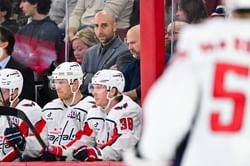
![[In Photos] Kris Letang, wife Catherine enjoy “a little bit of Italy” during picturesque European getaway to celebrate two decades of togetherness](https://staticg.sportskeeda.com/editor/2025/09/72749-17579357334704-1920.jpg?h=166)

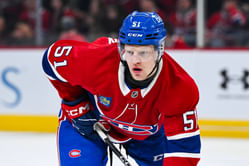
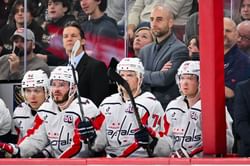

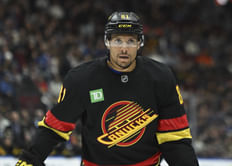
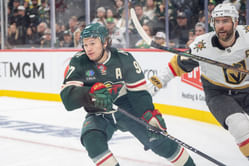

![Evander Kane’s fiancée Mara Teigen poses in halter-neck bodycon dress ahead of NHL preseason [In Pictures]](https://staticg.sportskeeda.com/editor/2025/09/adc0b-17578827899847-1920.jpg?h=166)